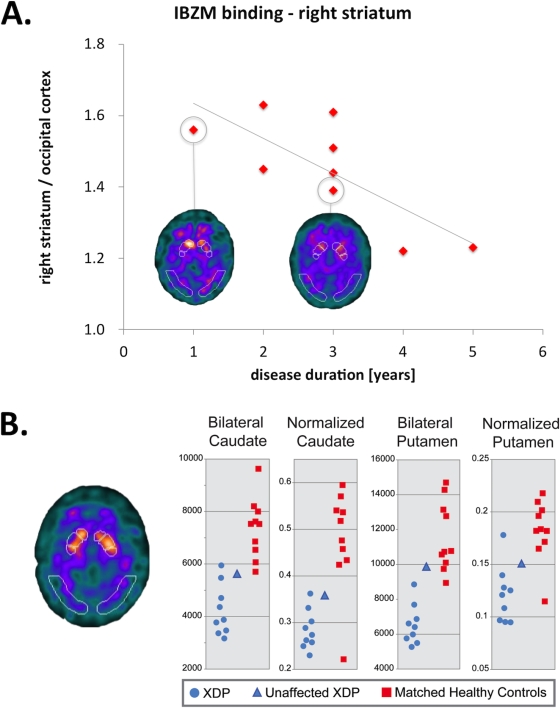Session Information
Date: Thursday, June 23, 2016
Session Title: Dystonia and Pediatric Movement Disorders
Session Time: 12:00pm-1:30pm
Objective: To assess pre- and postsynaptic dopaminergic function in X-linked dystonia-parkinsonism (XDP).
Background: X-linked dystonia-parkinsonism (XDP) is a neurodegenerative adult-onset movement disorder associated with striatal atrophy. It is unclear whether nigrostriatal dysfunction contributes to parkinsonism in this basal ganglia model disease.
Methods: We obtained a total of 10 IBZM SPECTs in 9 patients aged 42.3±9.5 years, 1 asymptomatic mutation carrier (38 years) and FP-CIT SPECTs in four patients, aged 41.5 ± 11.6 years. We also performed structural MRI in mutation carriers and 10 matched healthy controls.
Results: All patients were male and suffered from severe segmental or generalized dystonia and varying degrees of parkinsonism. IBZM SPECTs were pathologic in 8/9 symptomatic patients, and unremarkable in the asymptomatic mutation carrier [fig A and B]. Longer disease duration (rho=-0.77, P=0.016) was associated with lower IBZM binding ratios [fig A]. Visual inspection of FP-CIT SPECTs revealed slightly reduced striatal tracer uptake in 3/4 patients. In the asymptomatic mutation carrier, basal ganglia volume was intermediate between healthy Filipino controls and symptomatic XDP carriers who presented striking atrophy. [fig B]. 
Conclusions: Unlike Parkinson’s disease with nigrostriatal degeneration, the current study supports the hypothesis that striatal dysfunction is the primary source of both dystonia and Parkinsonian symptoms in XDP. The functional decline of postsynaptic dopaminergic neurotransmission is related to XDP disease duration and thus to ongoing neurodegeneration. Compensatory up-regulation of postsynaptic dopamine receptors into the normal range in the asymptomatic mutation carrier may be one of the mechanisms by which the brain counteracts ongoing striatal degeneration. As the disease is rapidly progressive in the first few years, the breakdown of compensatory mechanisms appears abrupt and much more pronounced than in other neurodegenerative movement disorders such as Huntington’s and Parkinson’s disease.
To cite this abstract in AMA style:
N. Brüggemann, R.L. Rosales, J.L. Waugh, A.J. Blood, A. Domingo, M. Heldmann, R.D. Jamora, A. Münchau, L.V. Lee, I. Buchmann, C. Klein. Striatal postsynaptic dysfunction in X-linked dystonia-parkinsonism is associated with disease progression [abstract]. Mov Disord. 2016; 31 (suppl 2). https://www.mdsabstracts.org/abstract/striatal-postsynaptic-dysfunction-in-x-linked-dystonia-parkinsonism-is-associated-with-disease-progression/. Accessed December 6, 2025.« Back to 2016 International Congress
MDS Abstracts - https://www.mdsabstracts.org/abstract/striatal-postsynaptic-dysfunction-in-x-linked-dystonia-parkinsonism-is-associated-with-disease-progression/
